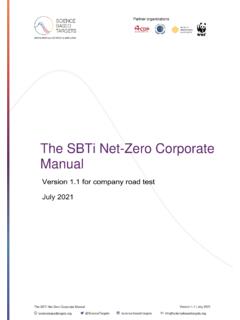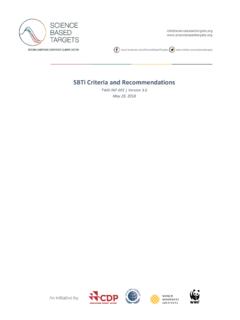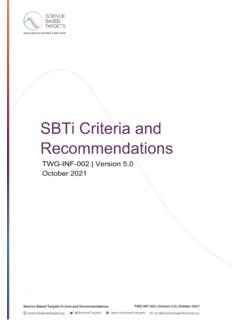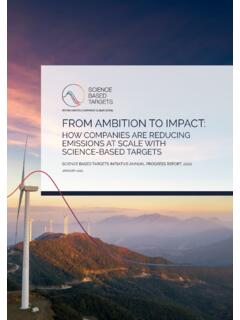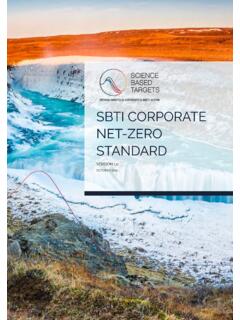Transcription of SETTING 1.5°C-ALIGNED SCIENCE-BASED TARGETS: …
1 SETTING C-ALIGNED SCIENCE-BASED TARGETS: QUICK START GUIDE FOR ELECTRIC UTILITIESJUNE 2020 DEVELOPED BYWITH SUPPORT FROMACKNOWLEDGMENTS This guidance was developed by CDP on behalf of the Science based targets initiative with support from Guidehouse. The Science based targets initiative mobilizes companies to set SCIENCE-BASED targets and boost their competitive advantage in the transition to the low-carbon economy. It is a collaboration between CDP, the United Nations Global Compact, World Resources Institute (WRI) and the World Wide Fund for Nature (WWF) and one of the We Mean Business Coalition commitments. Guidehouse is a specialized, global professional services firm. With over 700 consultants, Guidehouse s global Energy, Sustainability, and Infrastructure segment is the largest in the industry.
2 We collaborate with and serve as trusted advisors to utilities and energy companies, large corporations, investors, NGOs, and the public sector to help them thrive in the rapidly changing energy, resources, and infrastructure environment. We lead through our insights and excel at strategy, transformation, and implementation, creating more sus-tainable and resilient countries, governments, companies, cities, and the development of this work, we also had the advice of the SBTi Scientific Advisory Group and stakeholders participating in a public consultation webinar in March authors:Andres Chang, CDPJ eroen Scheepmaker, GuidehouseOskar Krabbe, GuidehouseAnnemarie Kerkhof, GuidehouseWe would like to thank Fernando Rangel Villasana (WWF), Nate Aden (WRI), and Mariana Heinrich (WBCSD) for their contributions to this by.
3 CONTENTSI ntroduction 4 Electric utilities play a crucial role in a decarbonized society 4 decarbonization options for electric utilities 5 What the science tells us is necessary 6 Guiding near-term action 7 The role of carbon dioxide removal 8 How to set a SCIENCE-BASED target 9 Step 1: Calculate emissions inventory 9 Step 2: Determine target scope and approach 10 Step 3: Construct targets 13 Step 4: Submit targets to SBTi 15 Additional resources 16 Effective dates of sector-specific requirements 16 References 17 SETTING C-aligned SCIENCE-BASED targets : Quick Start Guide for Electric Utilities | 4 INTRODUCTIONThe Intergovernmental Panel on Climate Change s (IPCC s) Special Report on Global Warming of C has laid out a stark obligation.
4 We must pursue rapid, far-reaching, and unprecedented changes in all aspects of society to hold temperature rise to C above preindustrial levels or face irreversible damage to our societies, economies, and the natural world (IPCC, 2018). In response to this urgency, the Science based targets initiative (SBTi) has introduced technical resources that enable companies to set greenhouse gas (GHG) emissions reduction targets in line with the flagship goal of the Paris Agreement, limiting warming to C. This guidance accompanies the SBTi s selection of a set of C pathways for the power sector and specifies how these pathways may be used to establish emissions reduction targets that demonstrate the highest level of climate utilities play a crucial role in a decarbonized societyIn all climate scenarios that limit warming to C, the share of electricity in final energy consumption grows steadily between 2020 and 2050 (Rogelj, et al.)
5 , 2018). Reasons for this trend are multifaceted but primarily reflect the potential for electricity to decarbonize at a much faster rate than alternative energy carriers. Trends in projected electricity growth are shown in Figure 1. Thousand TWh40302010 02000 2010 2020 2030 2040 2018 2020 2030 2040 2018 2020 2030 2040 5040302010 0 Thousand TWh United States European Union Japan Other advanced economies China India Other developing economies Industry Residential Services Transport Other final uses Power servicesSustainable DevelopmentStated PoliciesFigure 1: Projected increase of global electricity use in the IEA s Stated Policies Scenario (left) and the increase of electricity use in several economic sectors in the IEA s Stated Policies Scenario and Sustainable Development Scenario (right) (International Energy Agency, 2019a).
6 Companies and utilities are recognizing the business benefits of taking climate action, finding that it helps to improve brand reputation, increases investor confidence, boosts resilience against regulations, and achieves cost reductions. Corporate leadership can also advocate for strong climate policy, as current policies are insufficient for meeting the global goal of limiting warming to C. The debate has quickly shifted from what is practical or easy the incremental changes and quick wins to action that is grounded in the latest C-aligned SCIENCE-BASED targets : Quick Start Guide for Electric Utilities | 5 decarbonization options for electric utilities The power sector can establish steep emissions reductions due to rapid technology cost reductions for solar, wind, and storage; expansion of enabling conditions that arise from national and subnational goals; and growing demand for renewable electricity.
7 Figure 2 shows the increase in volume of power purchase agreements (PPAs), a trend that is likely to continue in coming years as many companies outside the power sector incorporate purchased renewable energy through bundled PPAs into their climate action strategies. Nonetheless, electric utilities also need to establish innovative business models around smart grids, demand management, and energy storage to be consistent with a net-zero economy. The next section examines scenarios for the power sector and the following section reviews SCIENCE-BASED target- SETTING methods and provides practical 2009 2010 2011 2012 2013 2014 2015 2016 2017 2018 2019 YTD Technology Communications Materials Consumer staples Government & university Manufacturing Financials Other Figure 2: Global PPA volumes by sector, 2009-2019 (International Energy Agency, 2019b).
8 Thomas / flickrSetting C-aligned SCIENCE-BASED targets : Quick Start Guide for Electric Utilities | 6 WHAT THE SCIENCE TELLS US IS NECESSARYL imiting warming to C means that global GHG emissions need to be reduced by half by 2030 and to approach net-zero by 2050 (Johan Rockstrom, 2017; UNEP, 2019). This requires a comprehensive transformation across virtually all economic sectors. The energy system will play a central role in this transformation, as nearly three-quarters of today s emissions are energy-related mainly the combustion of fossil fuels (Figure 3). Decarbonizing the power sector is key to the energy system transition. If increasingly grave risks are to be avoided, decarbonizing the power sector will require the sustained rapid growth of renewable electricity and significant reductions in coal-fired and gas-fired generation at a global level over the next 10 years (Grant & Coffin, 2019, pp.)
9 38-41; Chang, 2020).401787957 Energy 73%Electrcity and heat 13%Transportation15%Manufacturing and construction 13%Other fossil fuel combustion and fugitive emissions 14%Annual global greenhouse gas emissions by sectorGtCO2e/yearAgriculture, land use change, and forestry 17%Non-energy industrial processes and waste 10%Figure 3: Annual global GHG emissions by sector based on recent historical data ( rsted, 2020).The deep decarbonization of the power sector is a robust outcome of all modeled scenarios that limit warming to C in the IPCC s Special Report on C. Sector emissions are reduced by 70%-92% between 2020 and 2035, approaching zero by around 2040-2045 (Figure 4). Other characteristics of the power sector transition show more variation across scenarios, like growth in electricity generation, the sector s mix of primary energy sources, and the sector s deployment of bioenergy carbon capture and storage (BECCS).
10 United Nations Photo / flickrSetting C-aligned SCIENCE-BASED targets : Quick Start Guide for Electric Utilities | 7150010005000-5002020 2030 2040 2050 2060 YearEmissions (MT CO2/yr)Global electricity CO2 emissionsFigure 4: Global emissions from electricity generation. Interquartile range of all C low/no-overshoot scenarios (gray shaded area), SBTi C power pathways (blue), and excluded pathways (orange). Black line is MESSAGE-GLOBIOM Low Energy Demand scenarioGuiding near-term actionTo determine minimum ambition, modeled scenarios used by the SBTi should be plausible, consistent, responsible, and objective relative to the desired goal of limiting warming to C or well-below 2 C (Science based targets initiative, 2019).
